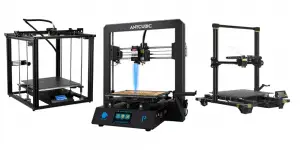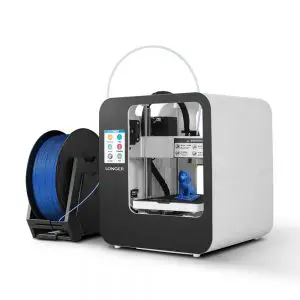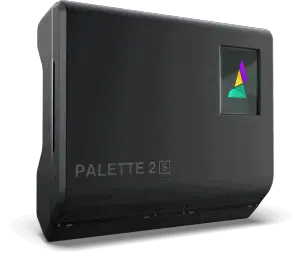Every serious designer and hobbyist needs a way to print out high-quality objects. The Replicator 2X printer provides exceptional quality with the ability to create a two-tone design from any SD card or via a USB cord. This review will provide the information you will need to decide whether the high-end cost for the 3D printer is worth the cost and effort. One of the biggest advantages happens to be exceptional quality items with quick turnout times.
Makerbot Replicator 2X Technical Specifications
- Max Print Size – 19.1 x 20.9 x 12.8 inches
- File Format – STL, OBJ, Thing
- Supported Filament Types – ABS and dissolving filaments like HIPS
- Filament Diameter – 1.75 millimeter
- Printer Speed – 200 millimeters per second
- Extruders – Two
- Extruder Diameter – 0.4 millimeter
- Printing Plate – heated aluminum
Makerbot Replicator 2X Design and Features
Most people first notice the dual printing heads when peering through the clear dome on the top of the printer covering the mechanisms. Clear sight into the workspace lets the user see the entire build as it prints to catch any problems. We must say watching the machine work is captivating. The chambers sit side by side working horizontally with a quiet hum as any number of creative items take shape. With no need to switch out filaments, the double print heads keep the build going without pausing to change colors.
The six sides of the printer are sealed tightly to ensure that there are no major temperature changes during operation. The printer features a draft-blocking design that minimizes the chance of problems like cooling unevenly or prematurely. Shrinkage and issues with cracks, pits, pocks, and holes are less likely to occur with this Replicator 2X model.
At just under 30 pounds, the Makerbot Replicator 2X is compact and light enough to fit on most work tables or desks. The sleek, modern design is sturdy yet stylish with a black, metal frame and clear PVC sides. Matte black hinges and screws blend into the design so as not to detract from the overall look of the printer. Sleek, dark handles and an LED display with push-button controls make using the machine comfortable. A directional display and scroll menu are user-friendly allowing operators to use the replicator easily. The digital readout is a decent size fitting the shape and length of the front panel nicely.
The aluminum printing plate is heated and provides precise results when allowing the machine to get to full temperature before the operation. A beep notification will signal when the plate is warm enough to begin printing. To continue, the user only needs to insert the filament into the extruder and feed it carefully until the mechanism in the print head grabs it. Once the extruder pulls the filament through the head and it emerges on the other end, the system is ready to start printing in one tone. The second head follows the same process to begin dual-tone printing. The user must heat each side separately to use the two print functions.
Many buyers suggest purchasing additional Kapton tape to keep the plastic from curling at the edges as the product cools. With over 350 cubic inches of space to print, the user can create larger items with the Replicator 2X than most 3D printers on the market. Overall, this printer offers exceptional results one might expect from a high-end model.
Printing
One of the most prominent characteristics of the final product is the quality of the print. Three resolution types at 100, 200, and 300 microns give printer owners several options for production. Most items need little to no touching up with the 300-micron option keeping start to finish times low. With 300 millimeters per second speed, printing an object is quick and efficient even when using both extruders at once.
If the production speed is important to a business, then this printer might keep overall times down. As long as the owner follows maintenance guidelines and knows how to unclog the nozzles without damaging the ceramic coating on the outside of the supply lines, the repair times should not detract from meeting shipping deadlines.

Dissolvable filaments like high impact polystyrene or HIPS, and acrylonitrile butadiene styrene, or ABS filaments are the only ones the manufacturer recommends using in this printer. By sticking with the MakerBot materials, the machine will clog less and create items with the best quality. Editing and adapting the prints after production may be less time consuming with this model versus others available.
Users will want to use the Kapton tape that comes with the printer because it will prevent sticking. Cutting a sheet of the material to fit the printing plate is the best way to reduce curling when using the ABS filament. The printer comes with several pages of the tape to allow for changing out the covering when necessary.
What Comes With The Makerbot Replicator 2X?
The Replicator 2X comes in many pieces the user must assemble upon receiving. Adding the handle is not a problem to install with a few turns of a screwdriver. Next, is the placement of the filament tubes and spools before hooking up the power supply unit.
After turning the printer on, it is time to level the printer plate. This step takes a bit because the plate may need leveling several times before setup is complete. The pressure on the device is sensitive and will be off with small bumps and movements. For some, this process is the most difficult part of operating the printer.
Leveling the plate requires paying attention to the display screen while tightening the alignment screws. Using a piece of paper, the installer can tighten or loosen the screws to get the plate to level. This step is perhaps the most tedious part of the process taking several times to level the plate to get the alignment correct.
Finally, following the instructions on the display menu, the filaments are easy to place. The motor in the extruder will grab the material as soon as it reaches the proper place in the tube. As soon as the material begins to exit the opposite end, the first side is ready. Following the same instructions, it is quick to load up the second spool. The temperatures and timing may be different when using both extruders together. Most users can completely set up the printer in about an hour.
What is in the box?
- Makerbot Replicator 2X
- A card with the number for technical support
- PTFE-based grease
- Power supply and cord
- MakerBot ABS Filament – one spool
- Two guide tubes for the filaments
- Two bolts and a handle
- A tool for applying MakerBot tape
- Several sheets of Kapton tape
- Spool holders
- User manual
- SD card
- USB cable
- Hex keys to tighten screws
MakerBot Support
For an affordable fee, MakerBot offers expert installation for the Replicator 2X. This optional service includes a full build and leveling of the printer. Hooking up the printer to a business or home computer is also part of the package. Next, the technician will add the driver programs and other software. Finally, a system test and a thorough clean will make sure the service technician leaves no hint of his or her work.
Pros & Cons of the Replicator 2X
Just like any product, the 3D printer has good and bad points. In this section, we list the most popular and lease favorite features of the Makerbot Replicator 2X.

Pros
- Double print capabilities allowing two-tone designs
- Heated aluminum plate
- Draft and temperature control technologies
- High-quality results
- Durable steel frame
- Sleek, modern design with clear sides for easy viewing
- Minimal or no bleeding or dying between colors
- High-quality prints
Cons
- Must assemble many moving parts
- Frequent clogs mean more time and effort to clear the extruders
- Prone to parts failures like the motherboard, jets, and cooling units
- No auto level feature
- Requires frequent calibration and needs a consistent temperature range to operate correctly
Verdict
Overall we would certainly recommend the Makerbot Replicator 2X. It’s a phenomenal printer that offers exceptional print quality. Some users feel this printer has a bit more of a learning curve than some other models. This is largely due to the leveling of the aluminum print plate. However, after a bit of tinkering, you’ll be able to level the print bed time and time again with ease.
Last update on 2025-06-05 / Affiliate links / Images from Amazon Product Advertising API





